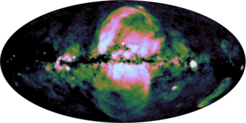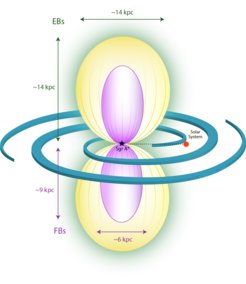SRG/eROSITA detects large-scale X-ray bubbles encompassing the Fermi bubbles
The first all-sky survey performed by the eROSITA X-ray telescope on-board the SRG observatory has revealed a large hourglass-shaped structure in the Milky Way. These “eROSITA bubbles” show a striking similarity to the Fermi bubbles, detected a decade ago at even higher energies. The most likely explanation for these huge features is a massive energy injection from the Galactic centre region in the past, leading to shocks in the hot gaseous halo around our galaxy.

The eROSITA bubbles. In this false-colour map the extended emission at energies of 0.6-1.0 keV is highlighted. The contribution of the point sources was removed and the scaling adjusted to enhance large-scale structures in our Galaxy.
In the southern part of the sky, a new huge circular structure below the plane of the Milky Way was found in the eROSITA X-ray map. A similar structure in the Northern sky, a “North polar spur”, has been known for a long time and had been thought to be the trace of an old supernova explosion. Taken together, the northern and the southern structures instead are reminiscent of a single hourglass-shaped bubble emerging from the Galactic center.
The large-scale X-ray emission observed by eROSITA in its medium energy band (0.6-1.0 keV) reveals the presence of gigantic bubbles at various levels of intensity throughout most of the sky, indicating that their intrinsic size is almost as large as the entire Milky Way (~10 kiloparsecs or up to 50,000 light-years across). These ‘eROSITA bubbles’ show striking morphological similarities to the well-known ‘Fermi bubbles’ detected at much higher energies (gamma-rays) by the Fermi telescope.
The bubbles now seen with eROSITA trace disturbances in the hot gas envelope around our Milky Way, caused either by a burst of star formation or by an outburst from the supermassive black hole at the Galactic centre. While dormant now, the black hole could well have been active in the past, linking it to other active galactic nuclei seen in distant galaxies. In either case, the energy needed to power the formation of these huge bubbles must have been enormous (1056 ergs, about the energy release of 100.000 supernovae, which is similar to estimates of other AGN outbursts).

“eROSITA is currently performing the second scan of the entire sky, doubling the number of X-ray photons coming from the bubbles it has discovered,” points out Rashid Sunyaev, scientific PI of the SRG Observatory. “We have a tremendous amount of work ahead of us because the eROSITA data make it possible to single out many X-ray spectral lines emitted by highly ionized gas. This means that the door is open to study the abundance of chemical elements, the degree of their ionization, the density and temperature of the emitting gas in the bubbles, and to identify the locations of shock waves and estimate characteristic timescales.”
The SRG spacecraft was designed by Lavochkin Association, Roskosmos corporation and launched on July 13, 2019 with a Proton launcher from Baikonur cosmodrome. The SRG observatory was built with participation of DLR, Germany in the framework of Russian Federal Space Program by the initiative of the Russian Academy of Sciences represented by its Space Research Institute (IKI). The observatory carries two unique X-ray grazing incidence telescopes: ART-XC (IKI, Russia) and eROSITA (MPE, Germany). The SRG/eROSITA telescope was built under the leadership of Max-Planck-Institute for Extraterrestrial Physics (MPE) and DLR. The SRG spacecraft is operated by Lavochkin Association and Deep Space Network Antennae in Bear Lakes, Ussurijsk, and Baykonur funded by Roskosmos.













